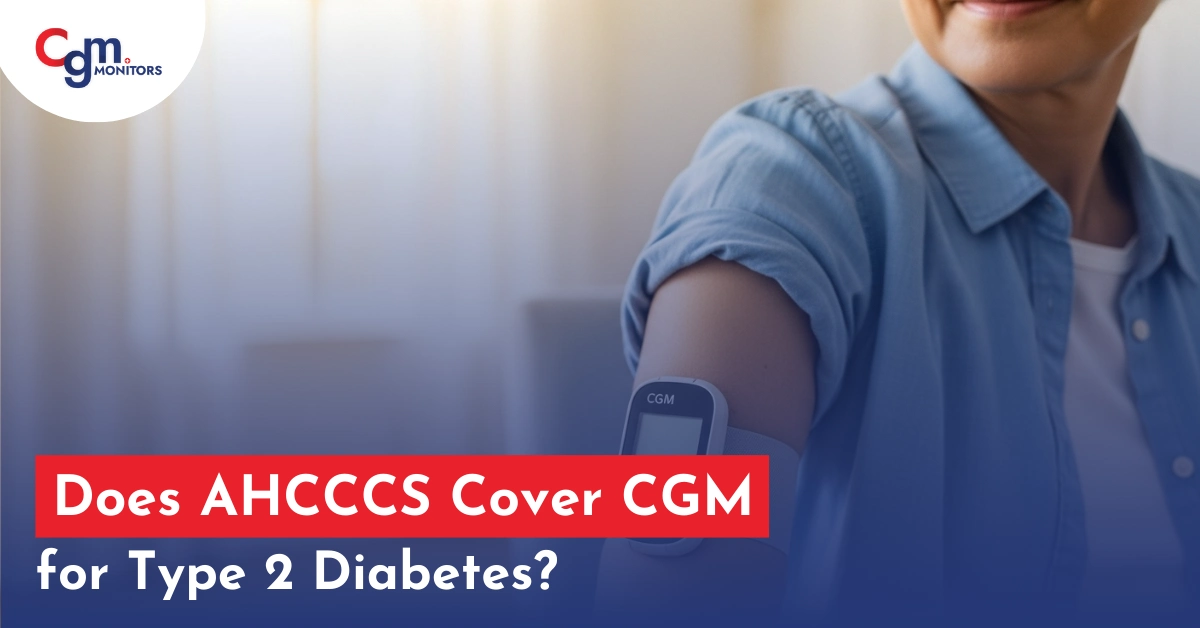Table of content
Managing Type 2 diabetes (T2D) involves monitoring blood glucose levels, and one of the most effective tools for achieving this is Continuous Glucose Monitor (CGM). However, when it comes to insurance coverage, many patients wonder whether AHCCCS (Arizona Health Care Cost Containment System), the state’s Medicaid program, will cover CGM devices for those with Type 2 diabetes.
Let’s explore how CGMs work, how insurance coverage generally functions, and specifically whether AHCCCS covers CGM for Type 2 diabetes.
How Insurance Typically Works for getting a CGM?
Insurance coverage for CGMs can vary widely depending on several factors, including:
- Medical Necessity: Most insurance companies will cover a CGM if it is deemed medically necessary. This typically includes individuals with Type 1 diabetes and Type 2 diabetics who are on insulin.
- Type of Insurance Plan: Coverage depends on the specific insurance provider and plan. Some plans may cover CGMs as part of durable medical equipment (DME), while others may classify it differently. The coverage details often depend on whether the CGM is considered a necessary part of managing diabetes.
- Pre-authorization and Documentation: Most insurers require pre-authorization to approve the CGM, which means patients need to provide medical documentation from their healthcare provider showing that the CGM is necessary for their treatment. This could include blood glucose logs, A1C levels, and evidence of insulin use or frequent blood sugar fluctuations.
- Out-of-Pocket Costs: Even if a CGM is covered, patients may still face out-of-pocket costs, such as deductibles, co-pays, or coinsurance. These costs vary depending on the patient’s insurance plan.
Does AHCCCS Cover CGM for Type 2 Diabetes?
AHCCCS is Arizona’s Medicaid program, designed to provide health insurance for low-income individuals. Many people with Type 2 diabetes in Arizona may wonder if AHCCCS covers a Continuous Glucose Monitor (CGM).
- For Type 2 Diabetes (T2D): AHCCCS typically does cover CGMs for people with Type 2 diabetes, but there are specific conditions that need to be met for approval. Generally, AHCCCS will cover a CGM for Type 2 diabetics who are on insulin therapy or who have difficulty controlling their blood glucose levels with standard methods like fingerstick testing.
- Medical Necessity: To receive approval from AHCCCS, patients usually need to show that the CGM is medically necessary for managing their diabetes. Medicare asks for your continued coverage documentation within 6 months prior to the “from” date of service on the claim. For example, patients who experience frequent blood glucose fluctuations or hypoglycemia (low blood sugar) may qualify for coverage.
- Approval Process: In order to get a CGM covered, patients will need to submit documentation to AHCCCS, including evidence of their diabetes treatment plan (such as being on insulin), A1C levels, and any complications related to their diabetes. It’s often helpful to work with your doctor to ensure the necessary documentation is submitted
Buy CGM Sensor online:
In case your insurance type does not cover a CGM at all, you can buy a CGM sensor using you credit/debit card from CGM Monitors. However, before making your purchase, you can fill out an eligibility form on the CGM Monitors website. This form helps us determine whether your insurance might still cover part of the cost or not.
Still wondering what Is a Continuous Glucose Monitor (CGM)?
A Continuous Glucose Monitor (CGM) is a device that keeps tracking your blood glucose levels 24/7 without the need of repeated finger pricks. The CGM works by measuring glucose in the interstitial fluid (the fluid between cells), unlike a BGM that takes your glucose readings directly from the blood.
A CGM consists of two main components:
- A small microneedle sensor worn usually at the back of upper arm. This keeps tracking your glucose levels from interstitial blood and a transmitter transmits this data.
- A receiver or smartphone app that displays glucose data usually in real-time, offering insights into trends, highs, and lows.
CGMs can alert users to high or low glucose levels, helping them make more informed decisions about diet, insulin, and exercise. This makes CGMs valuable for people with Type 1 diabetes and those with Type 2 diabetes who use insulin or have difficulty managing their glucose levels.
- Let Us Handle Your Insurance: Don’t worry about the complicated insurance claims process. After filling out the eligibility form, let us deal with your insurance company. We’ll work on your behalf to try and get the best possible outcome with your insurer, so you can focus on managing your health.
- Same-Day or Next-Day Delivery: With CGM Monitors, you can get your CGM device delivered to your doorstep in just a few days, giving you quick access to this life-changing tool.
Final Thoughts
While AHCCCS covers Continuous Glucose Monitors for eligible individuals with Type 2 diabetes, it often requires specific documentation to demonstrate medical necessity.
Still unsure whether or not you qualify for a CGM device? Get a free eligibility check now.










Write a comment
Your email address will not be published. All fields are required